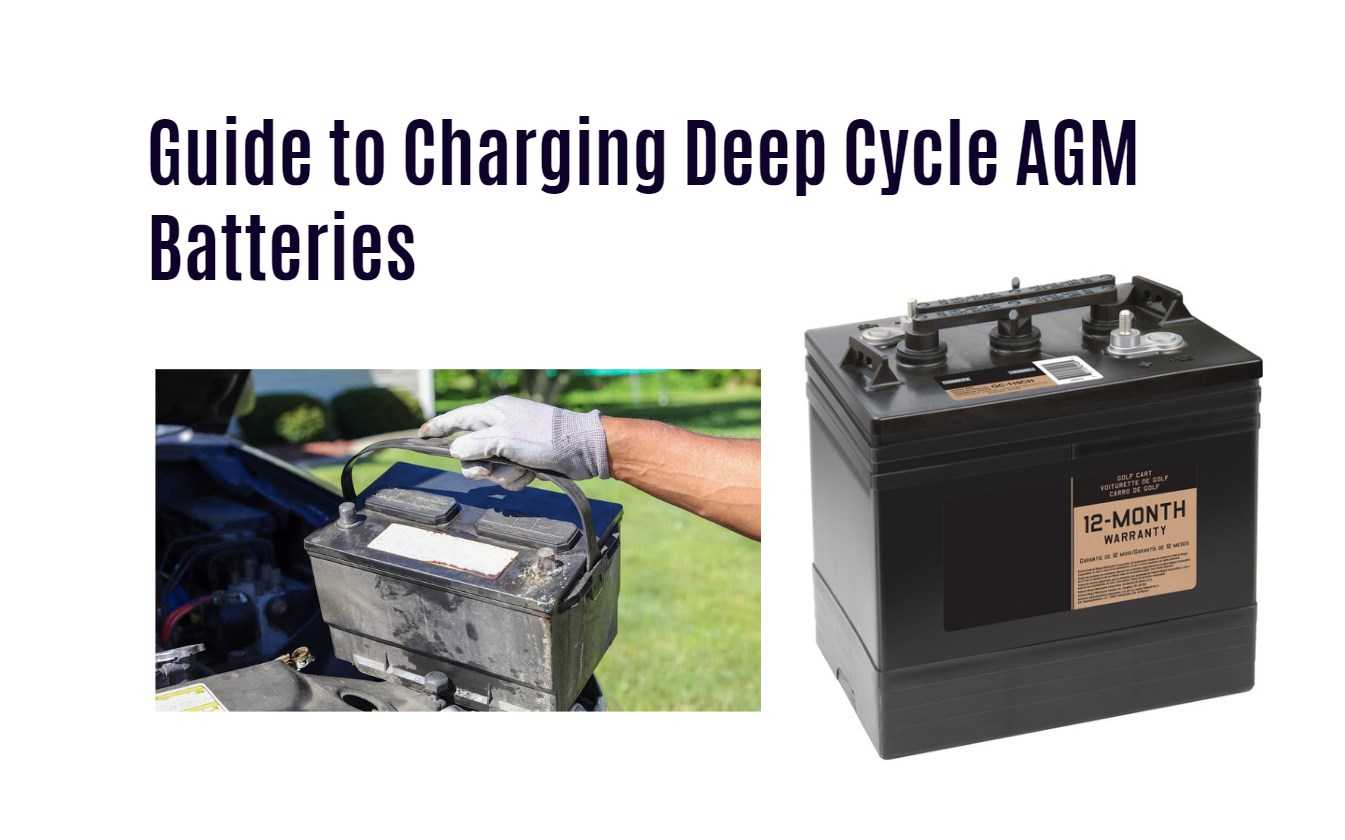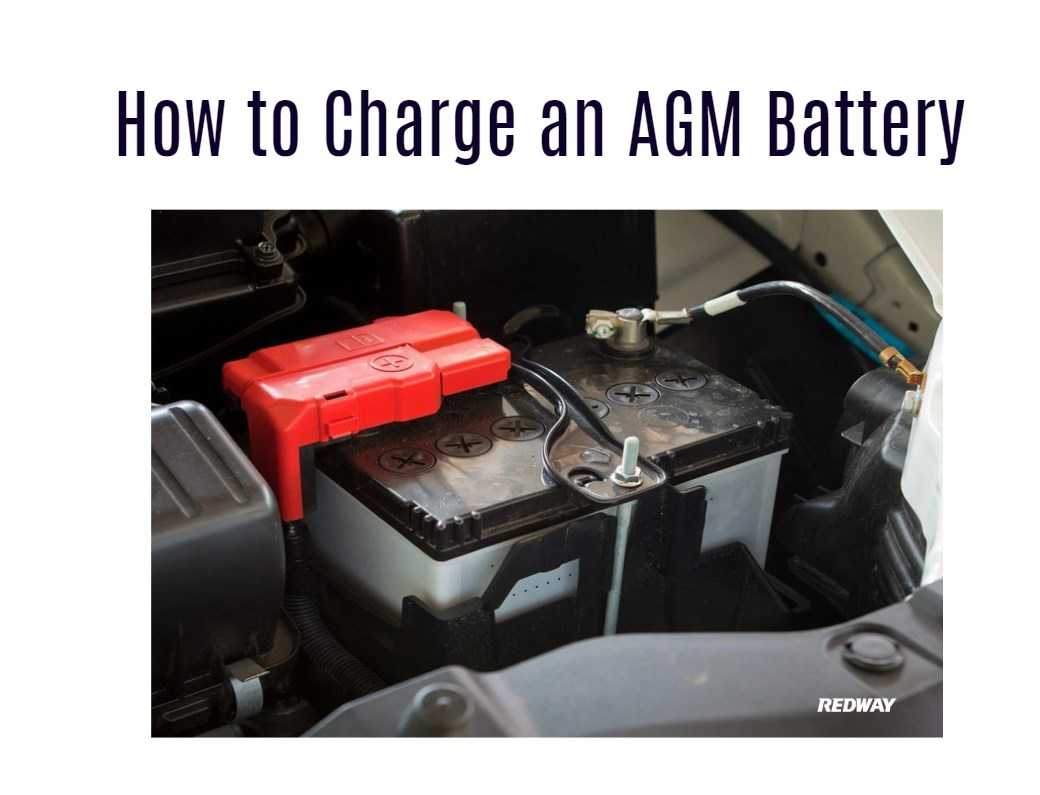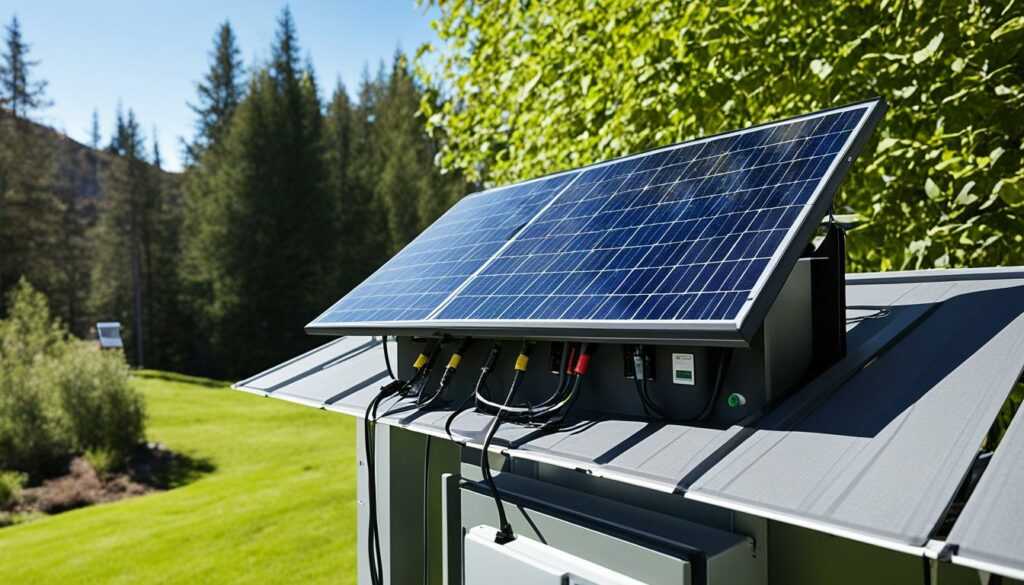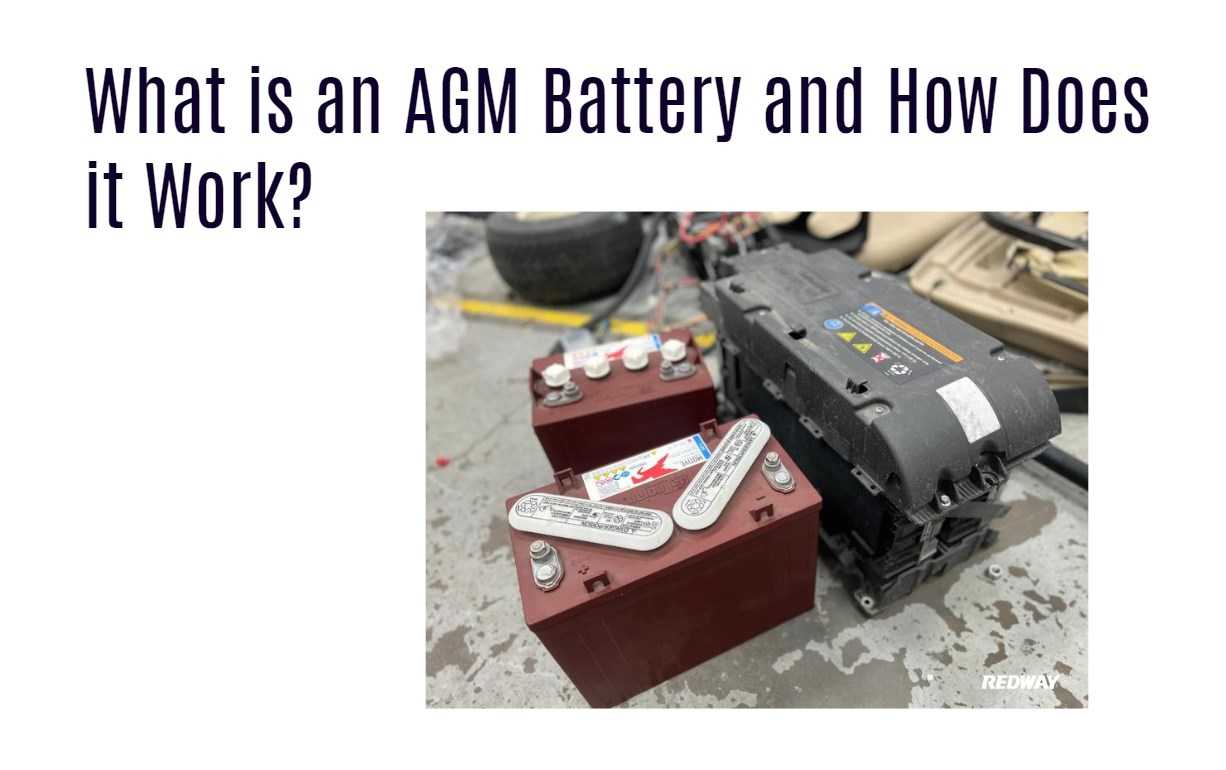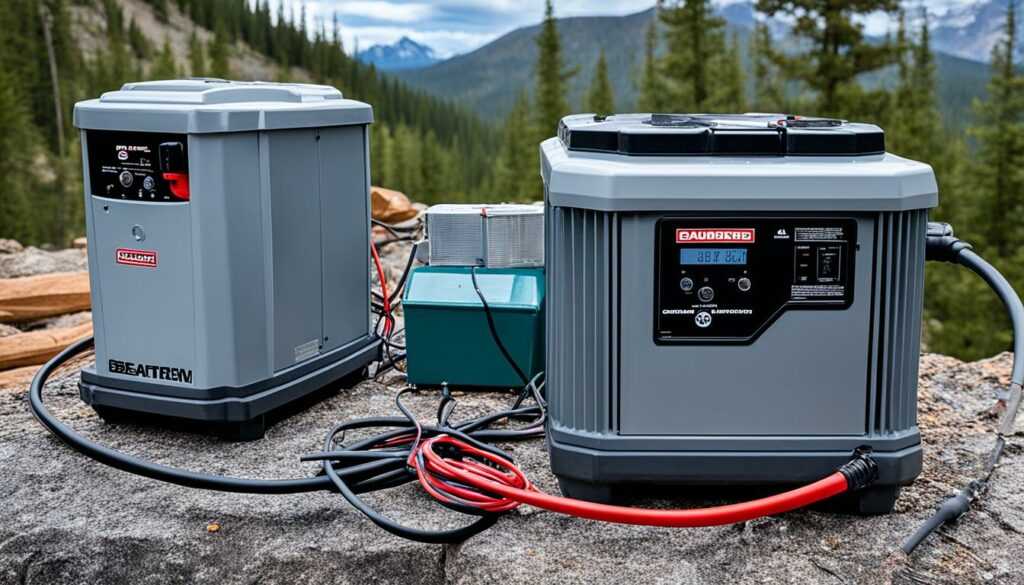Absorbed Glass Mat (AGM) batteries are great for many uses like in cars, boats, and RVs. They work for both starting up and continuous use, lasting a long time between charges. But, if you want your AGM battery to last, it needs to charge right.
To charge well, use a charger that works with AGM batteries. Make sure the charger is set to the right voltage and type of battery. Then, follow the three steps of charging: bulk, absorption, and float. Slowly charging an AGM battery keeps it from getting too hot and makes it live longer.
Key Takeaways:
- AGM batteries are versatile and provide long run time for various applications.
- Proper charging techniques are crucial for AGM batteries.
- Use an AGM-compatible battery charger and follow the three charging stages.
- Charging AGM batteries slowly helps prevent overheating and extends their lifespan.
- AGM batteries offer enhanced performance compared to standard flooded batteries.
How to Charge an AGM Battery.
To keep your AGM battery working well for a long time, it must be charged the right way. This guide will help you charge your AGM battery correctly, making it last longer.
Wholesale lithium golf cart batteries with 10-year life? Check here.
- Ensure Safety: Wear appropriate safety gear like gloves and safety glasses. Also, make sure to charge the battery in a well-ventilated area to prevent accidents.
- Connect AGM-Compatible Charger and Backup Power Supply: Plug an AGM-compatible charger into your car’s OBD-II port. Also, use a backup power source to guarantee a stable power supply throughout.
- Disconnect the Negative Terminal: Prior to starting, detach the negative battery terminal. This simple step avoids any electrical issues during charging and keeps you safe.
- Select the AGM Setting on the Charger: Choose the AGM or Absorbed setting on your charger. This setting meets the unique charging needs of AGM batteries for their best performance.
- Connect the Charger to the Battery: Join the charger’s leads with the battery posts correctly. A secure connection is important to charge the battery without problems.
- Start the Charging Process: After connecting everything, switch on the charger. Let the battery charge for two to eight hours, depending on how depleted it is.
- Disconnect and Reconnect: When done, unplug the charger and reconnect the negative terminal. Your battery is now fully charged and good to go again.
These steps make sure you charge your AGM battery the right way, improving its lifespan and function.
What is an AGM Battery Charger?
An AGM battery charger is made for AGM batteries. It keeps the voltage under 14-15 volts, sending more amps into the battery. This process involves three stages: bulk, absorption, and float. This ensures the battery is charged fully without going over the safe voltage for AGM batteries.
Want OEM lithium forklift batteries at wholesale prices? Check here.
Using a regular charger could be bad. It might overheat or dry out AGM batteries. So, it’s important to use a charger that’s made for AGM batteries.
The Three AGM Battery Charging Stages:
AGM battery chargers charge in three main steps:
- Bulk Charging: At first, the charger sends a high current. It charges the battery fast up to 80%.
- Absorption Charging: Then, it switches to a constant voltage. It reduces the current slowly. This helps the battery take in the remaining charge without getting too hot.
- Float Charging: A low charge is given to keep the battery full without overcharging. This maintains the battery until it’s needed.
Having a charger that goes through these stages is key. It ensures your AGM batteries get the right power. This helps their performance and lifespan.
Choosing the Right AGM Battery Charger:
Choosing the best AGM battery charger means looking at several things:
- Make sure the charger is really for AGM batteries. Using a different charger could harm your battery.
- Check the charger’s power to make sure it fits your battery’s needs. Look at the battery’s Ah rating.
- Choose a charger with safety features. Overcharge, short-circuit, and reverse polarity protection are important. They help keep your battery safe while charging.
Getting a top-quality charger makes a big difference. It keeps your AGM batteries working well for a long time. They’ll be reliable for all your uses.
| AGM Battery Charger | AGM Battery Charging Stages | AGM Battery Charging Requirements |
|---|---|---|
| Specifically designed for AGM batteries | Bulk charging | Charger compatibility with AGM batteries |
| Delivers more amps into the battery | Absorption charging | Charging capacity matching the battery’s requirements |
| Maintains voltage below 14-15 volts | Float charging | Built-in safety features (overcharge protection, short-circuit protection, etc.) |
How Long Does it Take to Recharge an AGM Battery?
The time to charge an AGM battery varies based on different factors. This includes the battery’s power details, current charge, and the charger’s amperage. Usually, it takes from two to eight hours to fully charge an AGM battery.
A charger with higher amperage can charge the battery quicker. On the other hand, chargers with lower amperage may need more time. You can figure out how long it will take by dividing the battery’s amp hours by the charger’s amp rating.
AGM batteries can take in high currents, which speeds up their charging. This quality makes them a top pick for applications needing fast and effective recharges.
Charging Your Battery from Solar Panels.
Solar panels are a great way to charge deep cycle batteries. They make use of sunlight to provide free energy. This means you can charge your batteries without using traditional power sources.
It’s crucial to have a solar regulator when you charge a battery with solar panels. A regulator controls the voltage from the panels, stopping the battery from getting too much power. This helps protect the battery and makes it last longer.
Regulators often have a feature that changes charging types when the battery is full. This is called float charge turning to trickle charge. It stops overcharging and keeps the battery at its best without needing you to watch it all the time.
Charging with solar panels is good for the environment. It uses clean energy and lowers your carbon footprint. It’s perfect for places without regular power access.
Now, let’s walk through how to charge a battery with solar panels:
- Step 1: Put your solar panels in a spot with lots of sunlight. They should be set up to catch sunlight well all day long.
- Step 2: Hook the solar panels up to a solar regulator. Make sure the regulator is made for deep cycle batteries and can handle your solar panels’ power.
- Step 3: Connect your deep cycle battery to the charge controller. Be careful to connect it the right way to prevent any damage.
- Step 4: Let the battery charge as the solar panels gather sunlight and turn it into electricity. The time it takes will depend on the size of your panels and your battery’s charge level.
- Step 5: Keep an eye on your battery’s charge through the controller’s display. When it’s full, the controller will make sure it doesn’t get overcharged.
- Step 6: Stop the charging by disconnecting the panels and the controller from the battery.
Using solar panels for charging makes you less reliant on regular power. It’s good for the planet and helps you live a sustainable life.
Advantages of Charging with Solar Panels
“Solar charging is good for the environment and uses the sun to power your batteries.”
Charging Your Battery from Your Vehicle Alternator.
Vehicle alternators are able to charge deep cycle batteries, like AGM ones. However, they might not be the best choice. They’re mainly for auto batteries and might not fully charge deep cycle ones.
It’s okay to charge a deep cycle battery with a car alternator. But, using a battery charger at home is better. This is because deep cycle batteries, like AGM, can lose life if not charged well.
When charging with an alternator, check the battery’s voltage. It must be high enough for a complete charge. The amount of charge a vehicle’s alternator gives can differ. This depends on your car’s make and model.
Know the right voltage to avoid battery problems. Deep cycle batteries need a bit more voltage than car batteries to charge fully. This prevents overcharging or undercharging.
Always keep an eye on your battery’s charge level. And, use a battery charger as needed to keep your battery healthy. For AGM batteries, using a charger made for them is even better.
Pros and Cons
| Pros | Cons |
|---|---|
| Convenient charging option when driving | May not fully charge deep cycle batteries |
| Cost-effective for occasional top-ups | Charging voltage may vary depending on vehicle |
| No additional equipment required | Potential risk of overcharging or undercharging |
Charging with the car’s alternator is handy while on the go. But, you need to know its downfalls. Be careful to keep your battery performing well and lasting long.
Visual representation of charging a deep cycle battery with a vehicle alternator.
Charging Your Battery from Your Generator.
Portable generators are handy for recharging deep cycle batteries, like AGM ones. Not all generators, though, can charge your battery automatically. For those without a built-in charger, you’ve got other ways to get the job done.
One method is to directly link your generator’s DC outlet to your battery. This needs a specific cable to connect them. Or, you can use a regular battery charger on the generator’s 240V socket. The charger then fills up your battery with the generator’s power.
Keep in mind, these ways are good for a quick charge, but not the most effective. Some generators, especially the higher-end ones, include chargers designed for better and faster battery charging. These chargers are smart, preventing your battery from getting too much charge.
Noise and fuel use should also be on your mind when charging with a generator. Generators are loud, so place them far from where you’re staying to lessen the noise. And always check you’ll have enough gas for the needed charging time.
But in general, you can use a generator to charge your battery when needed. Pick the best way, keep quiet and fuel use in check, and think about long-term needs. An advanced generator with its own charger might be the best choice if you use it a lot.
Generator Battery Charging Methods
There are two primary methods for charging your battery from a generator:
- Using a generator with a DC outlet and a compatible charging cable.
- Using a battery charger plugged into the 240V socket of the generator.
Considerations for Generator Battery Charging
When charging your battery with a generator, keep the following considerations in mind:
- Not all generators have built-in battery charging circuitry.
- Using a generator’s DC outlet or a battery charger plugged into the generator’s 240V socket is an alternative method.
- Some advanced generators come with built-in chargers for faster and more efficient battery charging.
- Always consider noise levels and fuel consumption when using a generator for battery charging.
What is an AGM Battery and How Does it Work?
AGM batteries, short for Absorbent Glass Mat, have a unique design. They use a fiberglass mat that sits between the battery’s positive and negative parts. This acts like a sponge to soak up the electrolyte. Because of this, AGM batteries won’t spill and can use more of the electrolyte without getting flooded.
AGM batteries have some cool benefits over traditional batteries. They have less internal resistance, which means they can move energy more efficiently and lower the chance of losing power. They also last through more charge and discharge cycles before they start to slow down.
Also, AGM batteries are tough against vibrations. This makes them good for things like boats and off-road vehicles where there are lots of bumps. Their ability to stand up to rough use means they keep working well even in hard environments.
AGM batteries also tend to get less sulfation. Sulfation is when the battery’s active parts form crystals, making it harder to hold a charge. The way AGM batteries are made helps prevent a lot of this, which keeps them running longer and stronger.
Besides, AGM batteries are lighter than regular batteries. The fiberglass mat they use helps cut down on the battery’s weight. This makes AGM batteries easier to move around and use in many different places.
Key Features of AGM Batteries:
- Unique construction with a fiberglass mat for optimal electrolyte absorption
- Non-spillable design
- Lower internal resistance for efficient energy transfer
- Longer cycle life compared to flooded batteries
- Vibration resistance for durability in challenging environments
- Reduced sulfation for extended battery lifespan
- Lighter weight for enhanced portability
AGM Battery vs. Gel Battery.
AGM batteries and Gel batteries are often used for many things. They are alike but have key differences.
AGM Battery Advantages
AGM batteries use a mat separator filled with electrolyte. This allows more contact with the plates. It brings several benefits:
- Enhanced Performance: Better contact helps electricity flow smoother. This means they work better and more efficiently.
- Lower Internal Resistance: AGM batteries charge and discharge quicker. This is because they have less resistance inside them than Gel batteries.
- Deep Cycling Capabilities: These batteries are good for using energy deeply and often. They are great for solar panels and in RVs.
Gel Battery Characteristics
Gel batteries use gel instead of liquid for their electrolyte. While they last a bit longer and have some strengths, they also have weaknesses:
- Not Suitable for High-Rate Discharge: They are not the best for situations where a lot of power is needed fast. AGM batteries do better in this case.
- Cold Temperature Performance: Gel batteries don’t like the cold as much. They might not work as well in chilly weather, unlike AGM batteries.
In general, people use AGM batteries more because they tend to be cheaper. They also have better performance, charge and discharge faster, and work well for heavy use.
The image above shows how AGM and Gel batteries differ. It helps you see their key features clearly.
AGM Battery vs. Lithium Batteries.
The choice between AGM batteries and lithium batteries depends on what you need them for. AGM batteries are great for many uses because of the benefits they offer.
- Lower Maintenance: AGM batteries require less upkeep than other types. They’re almost maintenance-free. You don’t need to check electrolyte levels or top up with water.
- Enhanced Performance: AGM batteries work well in all weather. They have a low resistance inside, which means they can power devices quickly and efficiently.
- Lower Self-Discharge Rate: These batteries lose power slower than others. So, they keep their charge for longer without needing to be recharged often.
- Affordable Pricing: AGM batteries cost less than lithium batteries. This makes them a good budget-friendly option for various uses.
Lithium batteries, on the other hand, have their own benefits that fit well in certain situations:
- Higher Energy Density: Lithium batteries store more energy in a smaller space. This quality makes them great for applications where saving space and reducing weight are key.
- Longer Lifespan: They last longer than AGM batteries. Lithium batteries can be charged and drained more times without losing their capacity too quickly.
- Faster Charging: Lithium batteries charge up quicker than AGM batteries. They are more efficient at taking in power, which gets them to full capacity faster.
- Lighter Weight: Lithium batteries are much lighter. This is a big advantage in things like electric cars, where keeping the weight down is critical.
Both types of batteries have their strengths. When picking, think about what the battery needs to do. AGM batteries might be best if you want something that doesn’t need a lot of care, performs well, and is budget-friendly.
On the flip side, lithium batteries excel if you need something that packs more energy, lasts longer, charges fast, and is lightweight.
| AGM Batteries | Lithium Batteries |
|---|---|
| Lower maintenance | Higher energy density |
| Enhanced performance | Longer lifespan |
| Lower self-discharge rate | Faster charging |
| Affordable pricing | Lighter weight |
Conclusion.
Charging deep cycle batteries correctly is important. It helps them work well for a longer time. To do this, follow the right charging methods. Also, use chargers that work with AGM batteries.
It’s vital to be safe when charging these batteries from solar panels or in vehicles. Always check the voltage and use the right tools.
AGM batteries are often better than other types like flooded or gel batteries. They have less resistance inside, last longer, and can take more shaking.
But, picking between AGM and lithium batteries depends on what you need. Think about how much energy you’ll use, how fast you want it to charge, and how much weight and space you have.
Looking after batteries and recycling them are both important for the planet. By doing these things, you help the environment stay healthy.
If you care for your AGM batteries the right way, they will last longer. This means less waste. Knowing how to charge and upkeep them makes sure you have power where you need it. Like in cars, boats, RVs, and more.
News
Advancements in Lead-Acid Battery Technology: Modern lead-acid batteries, including AGM types, now offer longer lifespans and faster charging capabilities due to advancements in battery chemistry and design. These improvements make them more efficient for high-demand applications.
AGM Battery Market Growth: The global AGM battery market is experiencing significant growth, driven by increasing demand for energy storage solutions and the expanding use of renewable energy sources. The market is projected to reach USD 22.85 billion by 2035, with a CAGR of 5.7%.
Integration of IoT Technology: The integration of IoT technology with AGM batteries allows for real-time monitoring of battery health and performance. This innovation enhances maintenance, optimizes performance, and extends battery life, contributing to a more sustainable and efficient energy storage sector.
FAQ
How should I charge an AGM battery?
To charge an AGM battery correctly, use a compatible charger. Make sure the charger’s voltage setting matches the battery’s needs. It’s important to go through three stages of charging: bulk, absorption, and float. Slow charging helps the battery last longer and avoids overheating.
What is an AGM battery charger?
An AGM battery charger is made to charge AGM batteries effectively. It has a system that controls the voltage to not go over 14-15 volts. This helps the battery avoid damage. The charger also follows the three charging stages to charge the battery well without harm.
How long does it take to recharge an AGM battery?
Recharging an AGM battery fully can take two to eight hours. The time it takes depends on the battery’s size, how much it’s already charged, and the charger’s power. A charger with higher power can recharge the battery quicker.
How can I charge a deep cycle battery with solar panels?
To charge a deep cycle, like an AGM, battery with solar, use a solar regulator. This device keeps the solar panel’s voltage safe so the battery doesn’t get overcharged. Solar panels offer a green and renewable way to power AGM batteries.
Can I charge my battery from my vehicle alternator?
Vehicle alternators can charge AGM batteries, but it’s not the best way. Using a battery charger when you have access to a power outlet is better. This approach helps maintain the battery’s health over time.
Can I use a generator to charge my deep cycle battery?
You can use a generator for this, but not all generators support battery charging on their own. You can either plug a battery charger into the generator or use a generator with a built-in charger. The latter option is more efficient for charging deep cycle batteries.
What is an AGM battery and how does it work?
AGM means Absorbent Glass Mat, a special battery design. It uses a mat made of fiberglass to hold the battery’s liquid without spilling. This design makes AGM batteries last longer and work better. They resist damage from shaking, have a longer life, and don’t develop sulfation as easily as other batteries.
What is the difference between an AGM battery and a gel battery?
AGM and gel batteries work in different ways but are good for many uses. AGM batteries have a fiberglass mat to hold the battery’s liquid, improving performance and lifespan. Gel batteries use a thick gel, which also holds the power well, but they can’t be used as hard or in very cold conditions.
Should I choose an AGM battery or lithium batteries?
Choosing between AGM and lithium batteries depends on what you need. AGM batteries are good if you don’t need a lot of power quickly and want a budget-friendly option. They last a long time and require less maintenance. Lithium batteries are best for situations where weight and space are important. They are powerful, light, and last a long time.


